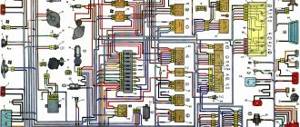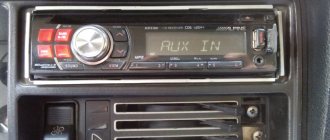Earbuds
No adjustment operations should be performed on the liners. If there are scuffs, marks or peeling, replace the liners with new ones.
The gap between the liners and the crankshaft journals is checked by calculation (by measuring the parts). It is convenient to use a calibrated plastic wire to check the gap. In this case, the verification method is as follows:
- thoroughly clean the working surfaces of the liners and the corresponding neck and place a piece of plastic wire on its surface;
- Install a connecting rod with a cap or a main bearing cap on the journal (depending on the type of journal being tested) and tighten the fastening nuts or bolts. Tighten the connecting rod bolt nuts to a torque of 51 Nm (5.2 kgf m), and the main bearing cap bolts to a torque of 80.4 Nm (8.2 kgf m);
- remove the cover and use the scale on the package to determine the size of the gap by flattening the wire (Fig. 2-38).
The nominal design clearance is 0.02-0.07 mm for connecting rods and 0.026-0.073 mm for main journals. If the gap is less than the limit (0.1 mm for connecting rods and 0.15 mm for main journals), then these liners can be used again.
If the gap is greater than the limit, replace the liners on these necks with new ones.
If the crankshaft journals are worn and ground to repair size, then replace the bearings with repair bearings (of increased thickness).
Thrust half rings
Just like on the liners, no adjustment operations can be performed on the half rings. If there are burrs, marks or peeling, replace the half rings with new ones.
Half rings are also replaced if the axial clearance of the crankshaft exceeds the maximum permissible - 0.35 mm. Select new half rings with a nominal thickness or increased by 0.127 mm to obtain an axial clearance in the range of 0.06-0.26 mm.
The axial clearance of the crankshaft is checked using an indicator, as described in the chapter “Engine Assembly” (Fig. 2-14).
The crankshaft axial clearance can also be checked with the engine installed in the vehicle. In this case, the axial movement of the crankshaft is created by pressing and releasing the clutch pedal, and the amount of clearance is determined by the movement of the front end of the crankshaft.
Marking of pistons VAZ 21213
Cars admin26.02.2020
Reg.: 12.12.2008 Threads / Messages: 2 / 4250 From: Omsk Age: 48 Car: VAZ-1118, 2008
Reg.: 04/22/2008 Threads / Messages: 1 / 1371 From: Ukraine, Melitopol Age: 33 Car: 21312 1997, 1.8K
Reg.: 12.12.2008 Threads / Messages: 2 / 4250 From: Omsk Age: 48 Car: VAZ-1118, 2008
Reg.: 04/15/2010 Messages: 2 From: Voronezh Age: 40 Car: VAZ-21213&96g.
gmv wrote: which is better? 1.Avtramat Kharkov 2.Motordetal 3.United Motors
Questions about point 1 have never arisen in 8 years, so we only use them.
Reg.: 05/14/2009 Messages: 116 From: Kostroma Age: 64 Car: VAZ 2131 1999 1.7 cc.
Reg.: 07/28/2008 Messages: 123 From: Samara Age: 42 Car: 2121 1982.
capital engine, there is a set of Kharkov pistons from 2105 (with recesses for the valves) - has anyone tried installing it on the 2106 engine? A master friend says that you can install it and then calmly fill it with gasoline from 76 to 92 - who can say from experience whether this is true or not? And what are the consequences? The gap at TDC to the mating plane of the head is really about two millimeters.
I got bored and bought a Niva.
Reg.: 12.12.2008 Threads / Messages: 2 / 4250 From: Omsk Age: 48 Car: VAZ-1118, 2008
Reg.: 07/28/2008 Messages: 123 From: Samara Age: 42 Car: 2121 1982.
I got bored and bought a Niva.
Reg.: 02/04/2009 Messages: 225 From: planet Norilsk. Age: 38 Car: 21213 95
I scrubbed the pistons a little to look at the markings and estimate the prices. The markings are made in a column: 1.) G - I still don’t understand what it is, either G Russian, or a triangle that is not completed on all the pistons, in the store they shrug their shoulders. 2.) -> the arrow shows how the piston is installed, directed towards the KV pulley. 3.) D- piston class (D – 81.995–82.005). 4.)2 - finger class (2 – 21.982–21.986).
Since only my 4th cylinder is moping, the finger dangles (knocks) a lot. Compression was normal (10.5-11) everywhere, the pistons in the block felt like they moved 1 mm from side to side, maximum 2 mm. Although it doesn’t seem like it should or feels like that. Hone marks are visible on the cylinder walls. You can take class D pistons with new rings and new pins and put it all back together. Or put it in class E so that it doesn’t dangle from side to side. Buy class E pistons and drag a block to sharpen it for these pistons. Here https://www.autoprospect.ru it says: Spare parts include pistons of classes A, C and E (nominal and repair sizes). Where did I get D?? And if the steel-bronze bushing in the connecting rod is broken, then you need to take all four connecting rods. since they should all be the same in mass, or one but with the same markings as the others?? Please tell me.
Reg.: 10/09/2007 Messages: 993 From: St. Petersburg Age: 51 Car: VAZ 21218 1999 VAZ 2121 2.0 FIAT
Reg.: 02/04/2009 Messages: 225 From: planet Norilsk. Age: 38 Car: 21213 95
Reg.: 12/06/2004 Threads / Messages: 4031 / 23190 From: Moscow Age: 65 Car: 21214M, 2013
Alexey aka ALER.
Reg.: 03/30/2010 Messages: 14 From: Orel Age: 47 Car: 2121 1981
Reg.: 10/09/2007 Messages: 993 From: St. Petersburg Age: 51 Car: VAZ 21218 1999 VAZ 2121 2.0 FIAT
Reg.: 03/30/2010 Messages: 14 From: Orel Age: 47 Car: 2121 1981
2.8.1. Device Features
Main dimensions of the connecting rod and piston group
Piston and connecting rod markings
| 180 posts on previous pages |
| 1 – arrow for orienting the piston in the cylinder; 2 – repair size; 3 – piston class; 4 – hole class for piston pin; 5 – connecting rod class based on the hole for the piston pin; 6 – cylinder number |
Places where it is allowed to remove metal when adjusting the mass of the upper and lower connecting rod heads
The piston is cast aluminum. During manufacturing, the weight of the pistons is strictly maintained. Therefore, when assembling the engine, it is not necessary to select pistons of the same weight group.
According to the outer diameter, the pistons are divided into five classes (A, B, C, D, E) every 0.01 mm. The outer surface of the piston has a complex shape. It is conical in height and oval in cross section. Therefore, it is necessary to measure the piston diameter only in a plane perpendicular to the piston pin, at a distance of 55 mm from the piston bottom.
Product added to bookmarks!
- Description
- Reviews
Standard crankshaft from the VAZ 2130 1.8L engine (OPP VAZ).
A crankshaft with a stroke of 84 mm (cast iron) is installed in the VAZ 21213 (Niva) and VAZ 2123 (Niva-Chevrolet, CHEVROLET NIVA) block together with
TDMK pistons (82.0 mm - 82.4 mm - 82.8 mm - 84.0 mm), with standard or lightweight connecting rods.
This crankshaft can be installed in the block of a VAZ 2103 (1.5L) and VAZ 2106 (1.6L) without replacing connecting rods and pistons (an accurate calculation of the compression ratio and adjustment of the combustion chamber will be required).
You can increase the engine displacement by: replacing the crankshaft with another one with a larger stroke, increasing the cylinder diameter, or both at the same time. We must not forget that when changing engine volume, it is necessary to increase the volume of the combustion chamber - to compensate for the increase in cylinder volume.
When installing a crankshaft with a long stroke, it is necessary to replace the pistons.
Boring the block cylinders by a significant amount (2 mm) must be approached with caution. For example, when a serial VAZ 21083 block is bored from 82 mm to 84 mm, the engine experiences increased oil consumption. This occurs due to the loss of block rigidity. In this case, it is better to use a special thick-walled block casting. VAZ produces such blocks in small batches.
An increase in engine displacement leads to an increase in maximum torque , but at the same time there is a decrease in maximum power speed. This is due to a decrease in mechanical efficiency. If the increase in volume occurs due to an increase in the diameter of the cylinders, then the contact area between the cylinder walls and the piston with piston rings increases. As a result, friction increases. If the increase in volume occurs due to an increase in the crankshaft stroke, then the average piston speed increases, which leads to the same results.
In any case, an increase in volume leads to a drop in the overall efficiency of the engine.
VAZ engine volume (in cubic cm) depending on the cylinder diameter and piston stroke.
Diameter Stroke, mm cylinder, 80 84 86 88 mm 76.0 1451 1524 1560 1596 76.4 1466 1540 1576 1613 76.8 1476 1556 1593 1630 79.0 1568 1646 1685 17 25 79.4 1584 1663 1702 1742 79.8 1600 1680 1720 1760 80.0 1608 1688 1628 1768 82.0 1689 1774 1816 1858 82.4 1706 1791 1834 1876 82.8 1722 1808 1851 1894 84, 0 1772 1861 1905 1950
ENGINE VAZ 21213-1000260
The engine is four-stroke, carburetor, in-line, with an overhead camshaft. The engine cooling system is liquid, closed type, with forced circulation of liquid. The engine has a combined lubrication system: pressure and splash.
| Engine Features. The VAZ 21213 engine can be used for installation on VAZ Niva cars: 2121, 21213, 21214, 2131; "Nadezhda" 2120 and their modifications. This internal combustion engine was developed specifically for the Niva VAZ-21213 car. Based on the center-to-center distance of the cylinders of 95 mm, it can be classified as a group of internal combustion engines installed on rear-wheel drive cars. They were located in the engine compartment along the axis of the car. Engine cylinder block 21213-1002011 with a center-to-center distance of 95 mm and a height of 214.58-0.1 mm (distance from the axis of rotation of the crankshaft to the upper surface of the block). The nominal diameter of the cylinders is 82mm. TBO dimensions - 82.40 and 82.80. Five classes are defined based on the deviation of the cylinder diameter. The size of each class differs from the previous one by 0.01mm. Classes are designated by letters (A, B, C, D). The cylinder block is marked on the bottom surface of the block. The engine is equipped with a crankshaft 21213-1005015. According to its parameters, it corresponds to the crankshaft 2103 and provides a piston stroke of 80 mm. (crank radius – 40mm.). The shaft has additional counterweights that reduce vibration. There are two oil supply holes on each crankpin. The diameters of the shaft journals are increased by 0.02 mm. When using standard bearings, this reduction in clearances optimizes the thickness of the oil layer between the shaft journal and the bearing surface. At the same time, reducing clearances improves the dynamic characteristics of the shaft. Crankshaft 21213 is recommended for installation instead of shaft 2103. A new piston group has been developed for the engine. Piston 21213 is of original design; it has a specific oval hole on the bottom. For piston diameters, classes corresponding to cylinder classes are defined. The hole for the piston pin is 22mm in diameter. In the piston, the hole for the piston pin is offset by 1.2 mm from the piston axis. The piston class marking by diameter and pin hole size is indicated on the piston bottom. The piston pin, 67 mm long, is fixed in the piston with retaining rings. The weight of the piston is 347g. During manufacturing, all pistons are brought to the same weight. Connecting rod 21213-1004045 has a new design. The length of the connecting rod is 136 mm. Hole sizes: for the connecting rod journal - 47.8 mm; piston pin – 22mm. New bolts were used to fasten the connecting rod cover, ensuring reliability and accuracy of assembly. The cylinder head 21213-1002011 (for a 1.7-liter engine) is structurally similar to the 21011 head, but has a number of differences. The height of the head 21213 is 111.0mm, which is 1.8mm lower than the head 21011. The size of the combustion chamber is 81x52 mm, volume 30 cm3. A new camshaft 21213-1006010 has been developed for the engine. The shape of the cams has been changed to increase the intake valve stroke. The valves and valve train from the 2101 engine are used. The camshaft drive is chain. Double-row bush-roller chain mod. 2103. A new extended tensioner shoe is used. Changes in the power system - the use of a 21073 Solex carburetor. The VAZ 21213 engine is equipped with a non-contact ignition system. The ignition distribution sensor 3810.3706 is responsible for creating control pulses for the switch. The ignition system uses a switch model - 3620.3734. Ignition coil - 27.3705.
Rate this article: Share with friends! ENGINE VAZ 2130-1000260 ENGINE VAZ 2106-1000260 ENGINE VAZ 2103-1000260 |











